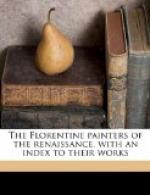VII.
[Page heading: NATURALISM IN FLORENTINE ART]
From the brief account just given of the four dominant personalities in Florentine painting from about 1430 to about 1460, it results that the leanings of the school during this interval were not artistic and artistic alone, but that there were other tendencies as well, tendencies on the one side, toward the expression of emotion (scarcely less literary because in form and colour than if in words), and, on the other, toward the naturalistic reproduction of objects. We have also noted that while the former tendency was represented by Filippo alone, the latter had Paolo Uccello, and all of Castagno and Veneziano that the genius of these two men would permit them to sacrifice to naturalism and science. To the extent, however, that they took sides and were conscious of a distinct purpose, these also sided with Uccello and not with Filippo. It may be agreed, therefore, that the main current of Florentine painting for a generation after Masaccio was naturalistic, and that consequently the impact given to the younger painters who during this period were starting, was mainly toward naturalism. Later, in studying Botticelli, we shall see how difficult it was for any one young at the time to escape this tide, even if by temperament farthest removed from scientific interests.




